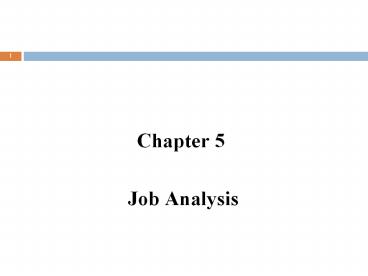Job Analysis - PowerPoint PPT Presentation
Title: Job Analysis
1
- Chapter 5
- Job Analysis
2
(No Transcript)
3
Definitions
- Job - Consists of a group of tasks that must be
performed for an organization to achieve its
goals. - Position - Collection of tasks and
responsibilities performed by one person there
is a position for every individual in an
organization. - Job Specification Statement of the needed
knowledge, skills, and abilities (KSAs) of the
person who is to perform the job. - Job Description Statement of the tasks, duties,
and responsibilities (TDRs) of a job to be
performed.
4
Job Analysis
- Job Analysis
- Systematic process of obtaining information
about the skills, duties, and knowledge required
for performing jobs in an organization. - HR managers use the information to develop job
descriptions and job specifications that are the
basis for recruitment, training, employee
performance appraisal and career development. - The ultimate purpose of job analysis is to
improve organizational performance and
productivity.
5
Job Analysis A Basic Human Resource Management
Tool
Tasks
Responsibilities
Duties
- Human Resource Planning
- Recruitment
- Selection
- Training and Development
- Performance Appraisal
- Compensation and Benefits
- Safety and Health
- Employee and Labor Relations
- Legal Considerations
- Job Analysis for Teams
Job Descriptions
Job Analysis
Job Specifications
Knowledge
Skills
Abilities
6
Reasons For Conducting Job Analysis
- Staffing would be disorganized if recruiter did
not know qualifications needed for job. - Training and Development if specification lists
a particular knowledge, skill, or ability, and
the person filling the position does not possess
all the necessary qualifications, training and/or
development is needed. - Compensation and Benefits value of job must be
known before dollar value can be placed on it. - Safety and Health helps identify safety and
health considerations.
7
Summary of Types of Data Collected Through Job
Analysis
- Work Activities work activities and processes
activity records procedures used personal
responsibility. - Personal requirements for the job personal
characteristics such as personality and
interests education and training required work
experience. - Machines, tools, equipment, and work aids
used.
8
Conducting Job Analysis
- The people who participate in job analysis
should include, at a minimum - 1. The employee.
- 2. The employees immediate supervisor.
9
Performing Job Analysis
- Step 1 Select jobs to study.
- Step 2 Determine information to collect Tasks,
responsibilities, skill requirements, etc. - Step 3 Identify sources of data Employees,
supervisors/managers. - Step 4 Methods of data collection
- Interviews
- Questionnaires
- Observation
- Diaries and Records
10
Performing Job Analysis
- Step 5 Evaluate and validate data collection
- Other employees
- Supervisors/managers
- Step 6 Write job analysis report.
11
Popular Approaches to Job Analysis
Position Analysis Questionnaire
Functional Job Analysis
Computerized Job Analysis
Critical Incident Method
12
Popular Approaches to Job Analysis
- 1. Position Analysis Questionnaire (PAQ model)
- is a structured questionnaire of job analysis
to measure job characteristics and relate them to
human characteristics. - it consists of 195 job elements that describe
common human work behaviors.
13
Popular Approaches to Job Analysis
- 2. Critical Incident Method
- Situation analysis technique in which actions or
behavior of an employee (during, for example, a
customer service event) is recorded and examined
to ascertain the actual requirements of a
successful operation. - a method for improving an employee's performance
by writing down and examining examples of what
they did particularly well or badly and how it
affected their work.
14
Popular Approaches to Job Analysis
- 3. Functional Job Analysis (FJA)
- Quantitative approach to job analysis that uses a
collected list of the various functions or work
activities that can make up any job. - FJA breaks down job roles into seven areas
things, data, worker instructions, reasoning,
people, maths and language. - Analysis of worker actions within these areas
plays a key part of the Functional Job Analysis
process.
15
Job Descriptions
16
Key Elements of a Job Description
- 1. Job Title
- Indicates job duties and organizational level.
- 2. Job Identification
- Distinguishes job from all other jobs.
- 3. Essential Functions (Job Duties)
- Indicate responsibilities entailed and results
to be. accomplished - 4. Job Specifications
- Basic skills required to perform the job and
physical demands of the job.
17
Problems with Job Descriptions
- If poorly written, they provide little guidance
to the jobholder. - They are not always updated as job duties or
specifications change. - They may break up the law by containing.
specifications not related to job success. - They can limit the scope of activities of the
jobholder, reducing organizational flexibility.
18
Job Design
- Job Design
- An result of job analysis that improves jobs
through technological and human considerations in
order to enhance organization efficiency and
employee job satisfaction. - Job Enrichment
- Enhancing a job by adding more meaningful tasks
and duties to make the work more rewarding or
satisfying. - Providing opportunities for achievement,
recognition, growth, responsibility, and
performance.
19
Job Enrichment Factors
- Increasing the level of difficulty and
responsibility of the job. - Allowing employees to retain more authority and
control over work outcomes. - Providing unit or individual job performance
reports directly to employees. - Adding new tasks to the job that require training
and growth. - Assigning individuals specific tasks, thus
enabling them to become experts.































